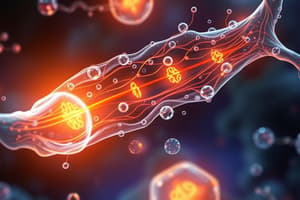Podcast
Questions and Answers
What defines the borders of the cell?
What defines the borders of the cell?
The plasma membrane
Which components are primarily found in the plasma membrane?
Which components are primarily found in the plasma membrane?
- Phospholipids
- Cholesterol
- Proteins
- All of the above (correct)
Carbohydrates are present on the inner surface of the plasma membrane.
Carbohydrates are present on the inner surface of the plasma membrane.
False (B)
What is the arrangement of phospholipids in the plasma membrane called?
What is the arrangement of phospholipids in the plasma membrane called?
Proteins in the plasma membrane can be categorized as ______________ and peripheral.
Proteins in the plasma membrane can be categorized as ______________ and peripheral.
The hydrophobic tails of phospholipids are water-fearing.
The hydrophobic tails of phospholipids are water-fearing.
In a typical human cell, proteins account for what percentage of the plasma membrane composition by mass?
In a typical human cell, proteins account for what percentage of the plasma membrane composition by mass?
What was first proposed in 1972 to describe the structure of the plasma membrane?
What was first proposed in 1972 to describe the structure of the plasma membrane?
Flashcards are hidden until you start studying
Study Notes
Cell Membrane Overview
- Defines cell boundaries and facilitates interaction with the environment.
- Regulates the intake, exclusion, and excretion of substances.
- Allows for cell communication through identification and information sharing.
- Composed of lipids for a semi-permeable barrier, proteins for transport and communication, and carbohydrates for cell recognition.
Fluid Mosaic Model
- Proposed in 1972; describes the plasma membrane as a dynamic structure.
- Composed of phospholipids, cholesterol, and proteins that move freely within the membrane plane.
- Membrane fluidity allows it to self-heal after punctures, exemplified when a needle is inserted.
Membrane Composition
- Lipids (primarily phospholipids and cholesterol), proteins, and carbohydrates are key components.
- Phospholipid structure: glycerol backbone, two fatty acid tails, and a phosphate-linked head group.
- Biological membranes typically have a phospholipid bilayer; hydrophilic heads face outward toward aqueous environments while hydrophobic tails point inward.
Phospholipids
- Amphipathic molecules with hydrophilic heads and hydrophobic tails.
- Hydrophilic heads interact well with water; they form electrostatic interactions with polar molecules.
- Hydrophobic tails conceal themselves within the bilayer, creating an effective barrier to polar substances.
Proteins in the Membrane
- Integral proteins are embedded within the membrane, with regions that interact with the hydrophobic core.
- Peripheral proteins are loosely attached to the membrane's inner or outer surface.
- Integral proteins can span the entire membrane or partially penetrate it, facilitating transport or signaling.
Carbohydrates
- Present on the outer surface of the plasma membrane, attached to proteins (glycoproteins) or lipids (glycolipids).
- Play a crucial role in cell recognition and communication.
Membrane Composition Variability
- Different cell types exhibit varying proportions of proteins, lipids, and carbohydrates.
- In a typical human cell: Proteins account for approximately 50% of mass, lipids for about 40%, and carbohydrates for around 10%.
Studying That Suits You
Use AI to generate personalized quizzes and flashcards to suit your learning preferences.




